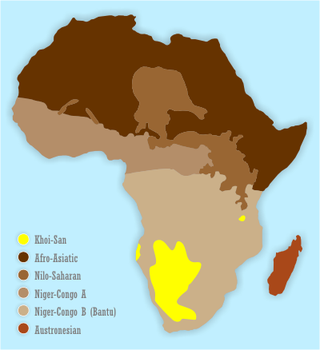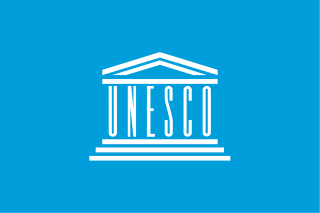
The Khoisan languages are a number of African languages once classified together, originally by Joseph Greenberg. Khoisan is defined as those languages that have click consonants and do not belong to other African language families. For much of the 20th century, they were thought to be genealogically related to each other, but this is no longer accepted. They are now held to comprise three distinct language families and two language isolates.
Nǁng or Nǁŋǃke, commonly known by the name of its only spoken dialect Nǀuu, is a moribund Tuu language once spoken in South Africa. It is no longer spoken on a daily basis, as the speakers live in different villages. The ǀʼAuni name for the Nǀuu, ǂKhomani, is used by the South African government. As of June 2021, only one speaker of the Nǀuu dialect remains, the rest of the population having shifted to Khoekhoe and Afrikaans.

ǀXam is an extinct language from South Africa formerly spoken by the ǀXam-ka ǃʼē people. It is part of the ǃUi branch of the Tuu languages and closely related to the moribund Nǁng language. Much of the scholarly work on ǀXam was performed by Wilhelm Bleek, a German linguist of the 19th century, who studied a variety of ǀXam spoken at Achterveld, and another spoken at Strandberg and Katkop while working with ǁKabbo, Diaǃkwāin, ǀAǃkúṅta, ǃKweiten-ta-ǁKen, ǀHaṅǂkassʼō and other speakers. The surviving corpus of ǀXam comes from the stories told by and vocabulary recorded from these individuals in the Bleek and Lloyd Collection.
ǃGãǃne (ǃGãǃnge) is an extinct language or dialect of the ǃKwi family which was once spoken near Tsolo and in Umtata District in South Africa, south of Lesotho. It is very poorly attested, with the only material being 140 words collected from two semi-speakers in 1931.
Gǁana is a Khoe dialect cluster of Botswana. It is closely related to Naro, and includes the well-known dialect Gǀwi, which has the majority of speakers.
ǃOrakobab or Khoemana, also known as Korana, ǃOra, or Griqua, is a moribund Khoe language of South Africa.

Hadza is a language isolate spoken along the shores of Lake Eyasi in Tanzania by around 1,000 Hadza people, who include in their number the last full-time hunter-gatherers in Africa. It is one of only three languages in East Africa with click consonants. Despite the small number of speakers, language use is vigorous, with most children learning it, but UNESCO categorizes the language as vulnerable.

The Tuu languages, or Taa–ǃKwilanguages, are a language family consisting of two language clusters spoken in Botswana and South Africa. The relationship between the two clusters is not doubted, but is distant. The name Tuu comes from a word common to both branches of the family for "person".
The Khoe languages are the largest of the non-Bantu language families indigenous to Southern Africa. They were once considered to be a branch of a Khoisan language family, and were known as Central Khoisan in that scenario. Though Khoisan is now rejected as a family, the name is retained as a term of convenience.

The UNESCO Atlas of the World's Languages in Danger was an online publication containing a comprehensive list of the world's endangered languages. It originally replaced the Red Book of Endangered Languages as a title in print after a brief period of overlap before being transferred to an online-only publication.
The Duru languages are a group of Savanna languages spoken in northern Cameroon and eastern Nigeria. They were labeled "G4" in Joseph Greenberg's Adamawa language-family proposal.

The Jukunoid languages are a branch of the Benue-Congo languages spoken by the Jukun and related peoples of Nigeria and Cameroon. They are distributed mostly throughout Taraba State, Nigeria and surrounding regions.
The Kwisi are a seashore-fishing and hunter-gatherer people of southwest Angola that physically seem to be a remnant of an indigenous population—along with the Kwadi, the Cimba, and the Damara—that are unlike either the San (Bushmen) or the Bantu. Culturally they have been strongly influenced by the Kuvale, and speak the Kuvale dialect of Herero. There may, however, have been a few elderly speakers of an unattested Kwisi language in the 1960s.
Kafoa, or Jafoo, is a Papuan language of Alor Island in the Alor archipelago of Indonesia. Although Kafoa speakers refer to both themselves and their language with the name "Kafoa", this word is not well known in the area. Kafoa speakers are frequently multilingual, also speaking Malay, Klon and Abui. Children are typically initially taught Malay by their parents and later acquire Kafoa after having reached school age.
The palatal nasal click is a click consonant found primarily among the languages of southern Africa. The symbol in the International Phonetic Alphabet for a nasal palatal click with a velar rear articulation is ⟨ŋ͡ǂ⟩ or ⟨ŋ͜ǂ⟩, commonly abbreviated to ⟨ŋǂ⟩, ⟨ᵑǂ⟩ or ⟨ǂ̃⟩. Linguists who prefer the old IPA letters use the analogous Beach convention of ⟨ŋ͡𝼋⟩ or ⟨ŋ͜𝼋⟩, abbreviated ⟨ŋ𝼋⟩, ⟨ᵑ𝼋⟩ or ⟨𝼋̃⟩. For a click with a uvular rear articulation, the equivalents are ⟨ɴ͡ǂ, ɴ͜ǂ, ɴǂ, ᶰǂ⟩ and ⟨ɴ͡𝼋, ɴ͜𝼋, ɴ𝼋, ᶰ𝼋⟩. Sometimes the accompanying letter comes after the click letter, e.g. ⟨ǂŋ⟩ or ⟨ǂᵑ⟩; this may be a simple orthographic choice, or may imply a difference in the relative timing of the releases.
Zire (Sîshëë), also known as Nerë, is an extinct Oceanic language of New Caledonia. It has been extinct since April 2006. Zire is sometimes considered a dialect of Ajië.

The Khoe–Kwadi languages are a family consisting of the Khoe languages of southern Africa and the poorly attested extinct Kwadi language of Angola. The relationship has been worked out by Tom Güldemann, Edward Elderkin, and Anne-Maria Fehn.
The Southern Ryukyuan languages form one of two branches of the Ryukyuan languages. They are spoken on the Sakishima Islands in Okinawa Prefecture. The three languages are Miyako and Yaeyama and Yonaguni. The Macro-Yaeyama languages have been identified as "critically endangered" by UNESCO and Miyako as "definitely endangered".
ǁŨǁʼe, also rendered ǁKu-ǁʼe or ǁKuǁe, is an extinct ǃKwi language or dialect of South Africa, spoken near Theunissen in South Africa, and recorded by Dorothea Bleek in 1928. It was labeled "SIIc" in her classification. It is closely related to Seroa, but analysis of the recorded data has not been enough to determine the boundary between language and dialect.






